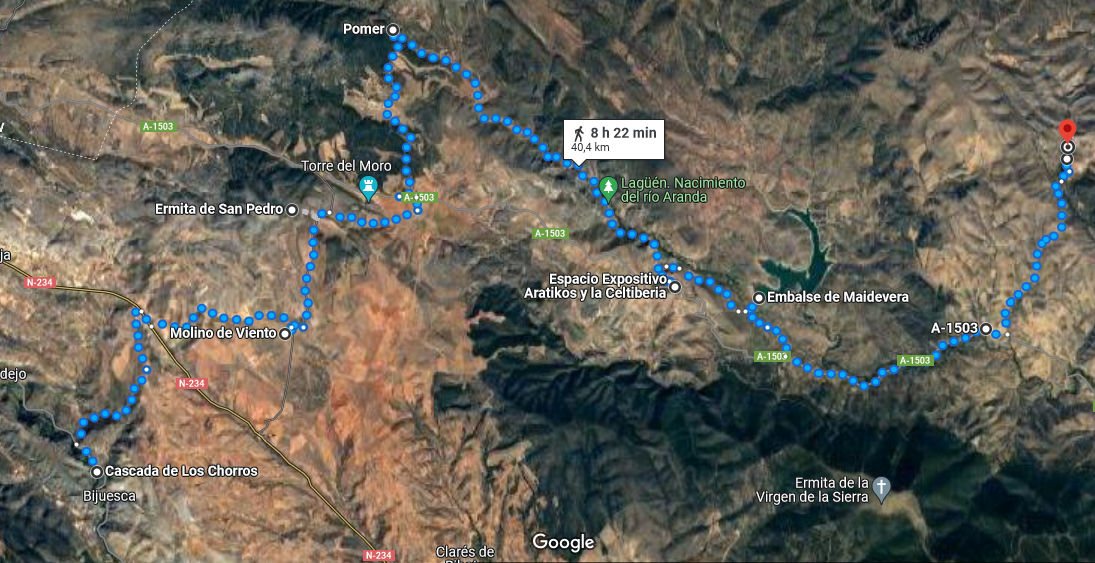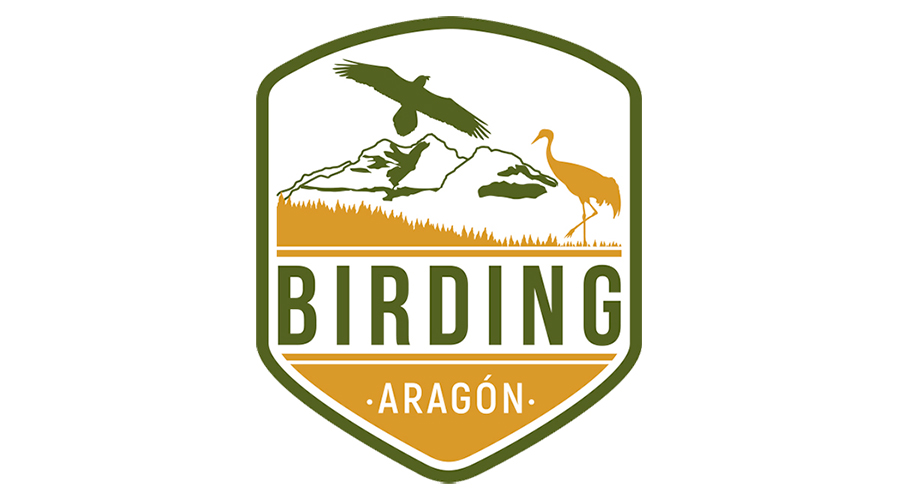ROUTES
RÉGION D’ARANDA
Comarca de Aranda
RECOMMENDED TIME TO VISIT: All year round
HABITATS: Riparian forests, rocky cliffs, wetlands, steppe and farmland mosaic.
ITINERARY
This includes part of the Celtiberian Range, to the south of Moncayo and to the north of the Virgin Sierra in the west of Aragon. It passes through varied habitats, from rocky cliffs to rainfed fields and steppes with natural vegetation, along riparian forests, wetlands and reservoirs, following part of the River Aranda’s course.
SPECIES
ALL YEAR ROUND: Chaffinch, White Wagtail, Cetti’s Warbler, Eurasian Treecreeper, Coal Tit, Blue Tit, Wren, Great Spotted Woodpecker, Dipper, Griffon Vulture, Eagle Owl, Golden Eagle, Bonelli’s Eagle, Calandra Lark, Sky Lark, Wood Lark, Corn Bunting, Thekla Lark, Crested Lark, Spectacled Warbler, Dartford Warbler, Great Bustard, Black-bellied Sandgrouse, Iberian Grey Shrike, Marsh Harrier, Montagu’s Harrier, Red Kite, Common Buzzard, Eurasian Jay, Northern Goshawk, Common Raven, Carrion Crow, Red-billed Chough, Little Owl, Rock Bunting, Blue Rock Thrush, Peregrine Falcon, Long-tailed Tit, Mallard, Grey Heron, Common Sandpiper, Common Coot, Little Grebe, Red Partridge, Common Quail, Redstart.
SUMMER: Egyptian Vulture, Black-eared Wheatear, Woodchat Shrike, Booted Eagle, Short-toed Eagle, Hobby, Merlin, Black Kite, Common Cuckoo, Cirl Bunting, European Bee-eater, Golden Oriole, Black-winged Stilt, Common Quail, Scop’s Owl.
WINTER: Hen Harrier, Mistle Thrush, Common Chiffchaff, Northern Shoveler, Great Cormorant
ON MIGRATION: Pied Flycatcher, Common Crane

POINTS OF INTEREST
LOS CHORROS WATERFALL
From the N234 Calatayud to Soria road, we take the left turn in Torrelapaja along the A1502, passing through Berdejo until we get to the municipality of Bijuesca where we start our route at the impressive Chorros waterfall (41.544774, -1.922870), 1,2km before arriving in Bijuesca itself. It’s an ideal place to enjoy nature and to watch birds, as it’s in an area of riparian woodland, bordered by rocky cliffs. Along this route we will discover various habitats where a diversity of woodland and waterside birds can be found.
BIRDS: Chaffinch, White Wagtail, Cetti’s Warbler, Eurasian Treecreeper. Furthermore there are many specialists of rocky cliffs, such as Griffon Vulture, Blue Rock Thrush, Egyptian Vulture (summer), Eagle Owl, Raven, Carrion Crow, Red-billed Chough or Bonelli’s Eagle, amongst others.
MALANQUILLA
We resume our journey along the A1502 to Torrelapaja until we meet the N234, direction Calatayud. At 9,8km we take a left turn along the Z-V-3443 to Malanquilla, winding our way along tracks until we reach one of the singular habitats of Aragón, the steppe and farmland mosaic. From the “Molino de viento” (Windmill) (41.568428, -1.8797209), which dates from before 1665 and is the iconic image of the village, we can find a great variety of birds linked to these ecosystems.
We continue along the Z-V-3443. At 2,5km from the windmill (direction A1503) we take a turning on the left along a track that takes us to a small chapel dedicated to St Peter (41.589808, -1.878228). The track is steep, but the views from the top are impressive, which makes it an ideal place to set up our telescope. Along the way we can freshen up at the freshwater spring.
BIRDS: Skylark, Corn Bunting, Black-eared Wheatear, Iberian Grey Shrike, Great Bustard, Little Owl, Common Kestrel, Hoopoe, European Roller, Calandra Lark and Black-bellied Sandgrouse. Along the way we can see raptors that use these steppe areas as foraging ranges such as the Booted Eagle, Short-toed Eagle, Hobby or Montagu’s Harrier.
LAGÜEN – SOURCE OF THE RIVER ARANDA
From the St Peter chapel we take the Z-V-3443 and turn left to the A1503. At the junction we turn right towards Aranda de Moncayo. 3,1km from the chapel we take a turning to the left towards the village of Pomer (41.592235- 1.853573). A little bit later we take a track on the right (41.620664,-1.855308), which leads us to the Valdepuertas gorge, an attractive gulley that takes us to the Source of the River Aranda (41.590909, -1.805613).
BIRDS: we can see woodland and farmland birds, such as the Common Buzzard, Red-billed Chough and Rock Bunting, amongst others. The source of the Aranda River is a picturesque and tranquil spot where we can see riverside and cliff birds, such as the European Bee-eater, Blue Rock Thrush, Peregrine Falcon, Eurasian Jackdaw, Alpine Swift or Golden Oriole, amongst others.
ARANDA DE MONCAYO
We continue our route until the village of Aranda de Moncayo, 2,2km from the source of the River Aranda, where we can make a stop at the new Aratikos and Celtiberia visitor centre (41.576540,-1.790399), which explains one of the most important Celtiberian settlements of the Iberian peninsula.
MAIDEVERA RESERVOIR
From the visitor centre we continue our route along the A1503 (direction Jarque, Gotor, Illueca) towards the Maidevera reservoir. 2km from Aranda de Moncayo, we turn left (41.575910,-1.789287) and stop at the rest area (41.572327, -1.773397) where we can set up our scopes. From this vantage point we can survey a new habitat, with reedbeds and water birds.
BIRDS: Mallard, Common Teal. Grey Heron, Great Crested Grebe, Little Grebe, Common Coot, Great Cormorant, Little and Great White Egret and Marsh Harrier, amongst others. At migration time we can also see Common Crane, which stop here if the water levels are right.
WALKING ROUTES
We continue along the A1503 towards the Seco Gorge (41.569515,-1.719646), where on the left there is a signposted walking route which over 550m takes us round agricultural fields where we can find steppe birds.
BIRDS: Red Partridge, Common Quail, Calandra Lark, Skylark, Thekla Lark, Black Wheatear, Black-bellied Sandgrouse, Great Bustard, Barn Owl, Marsh and Hen Harriers, European Bee-eater and Common Kestrel. Raptors also fly over these fields looking for food, such as Short-toed Eagle, Golden Eagle, Northern Goshawk, Eurasian Sparrowhawk, Common Buzzard and Peregrine Falcon, amongst others.
FUENTE DE TRES CAÑOS
We finish our route in Oseja at 4,9km from the Seco gorge. To get there we take the A1503 again (direction Jarque) and take the left turn (41.568405,-1.714401) to Oseja, one of the most picturesque villages of the county, set at 800m above sea level amongst the mountains. Once in the town, we follow the traditional wineries route, which date from the 18th and 19thC (41.598431, -1.700571) until we get to the Fuente de tres Caños (the “3 spout spring”) (41.600558, -1.700484), where we can see riverside and woodland birds.
BIRDS: European Robin, Redstart, Eurasian Treecreeper, Golden Oriole, Cirl Bunting, Wryneck, Nigtingale, Great Spotted Woodpecker, Coal Tit, Mistle Thrush, Black Kite or Golden Eagle. At this ideal spot to rest and unwind in we can also hear, if we are lucky, Eagle and Scops Owl.





